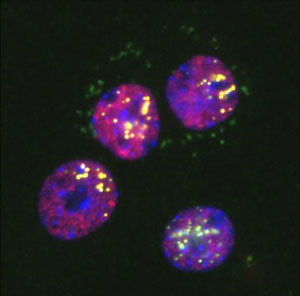Jan. 9, 2015 Research Highlight Biology
Finding the function of long noncoding RNA
Mouse experiments suggest that a noncoding RNA can be vital for successful pregnancy
 Figure 1: Fluorescence microscopy image showing the formation of paraspeckles (bright yellow) during development of corpus luteum cells (blue/pink). © 2014 Shinichi Nakagawa, RIKEN RNA Biology Laboratory
Figure 1: Fluorescence microscopy image showing the formation of paraspeckles (bright yellow) during development of corpus luteum cells (blue/pink). © 2014 Shinichi Nakagawa, RIKEN RNA Biology Laboratory
The proteins that underlie nearly all biological mechanisms are produced from RNA molecules transcribed from genetic sequences in DNA. However, a large proportion of transcribed RNA is not transcoded into proteins and appears to have no significant function. Shinichi Nakagawa from the RIKEN RNA Biology Laboratory and colleagues have now found that one particular long noncoding RNA (lncRNA) is essential for fertility in some circumstances1.
As part of a previous research program, Nakagawa and his team had bred a genetically engineered mouse strain with a ‘knock-out’ mutation on the gene encoding an lncRNA called Neat1. Although most lncRNA knock-outs show no significant effects, the researchers found high rates of infertility in these Neat1 knock-out females. So they decided to investigate further.
The team found that about half the female knock-out mice had fertility problems, either not becoming pregnant or producing small litters. The effects were surprisingly random, however. Some knock-out mice appeared to have normal pregnancies, others were always infertile, whereas still others were only sometimes infertile. “A particular female might become pregnant normally once, but at the next copulation, fail to become pregnant,” says Nakagawa.
Subsequent experiments pinpointed ovary malfunction as the cause of the infertility. The researchers also found that progesterone levels failed to rise during pregnancy in infertile knock-out mice. These findings implicated the corpus luteum, a structure formed in the ovary after fertilization and which releases progesterone.
In normal mice, Neat1 is produced in abundance by cells in the corpus luteum as it develops following fertilization, and is important in making spherical structures called ‘paraspeckles’ within the nuclei of the corpus luteal cells (Fig. 1). No paraspeckles formed in the knock-out mice, but despite the lack of paraspeckles about half of the knock-out mice had seemingly normal pregnancies.
The function of the paraspeckles and their importance in pregnancy therefore remain unclear. “One theory is that they sequester potentially harmful proteins,” says Nakagawa. “We think that Neat1 may fight against certain stresses that disrupt the establishment of pregnancy. If that stress is present, Neat1 and the paraspeckles are needed, but without that stress, the paraspeckles are not required.”
Nakagawa thinks it is quite possible that some forms of infertility in humans may also be attributable to defects in the Neat1 gene and paraspeckle formation. “We haven’t conducted any tests on humans yet, but definitely that is one of the future directions we would like to take with this research.”
References
- 1. Nakagawa, S., Shimada, M., Yanaka, K., Mito, M., Arai, T., Takahashi, E., Fujita, Y., Fujimori, T., Standaert, L., Marine, J.-C. et al. The lncRNA Neat1 is required for corpus luteum formation and the establishment of pregnancy in a subpopulation of mice. Development 141, 4618–4627 (2014). doi: 10.1242/dev.110544
